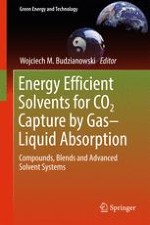2017 | OriginalPaper | Buchkapitel
Assessment of Thermodynamic Efficiency of Carbon Dioxide Separation in Capture Plants by Using Gas–Liquid Absorption
verfasst von : Wojciech M. Budzianowski
Erschienen in: Energy Efficient Solvents for CO2 Capture by Gas-Liquid Absorption
Aktivieren Sie unsere intelligente Suche, um passende Fachinhalte oder Patente zu finden.
Wählen Sie Textabschnitte aus um mit Künstlicher Intelligenz passenden Patente zu finden. powered by
Markieren Sie Textabschnitte, um KI-gestützt weitere passende Inhalte zu finden. powered by
